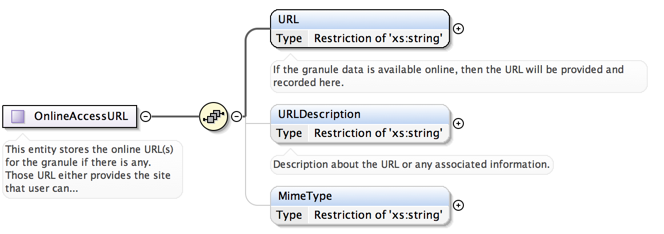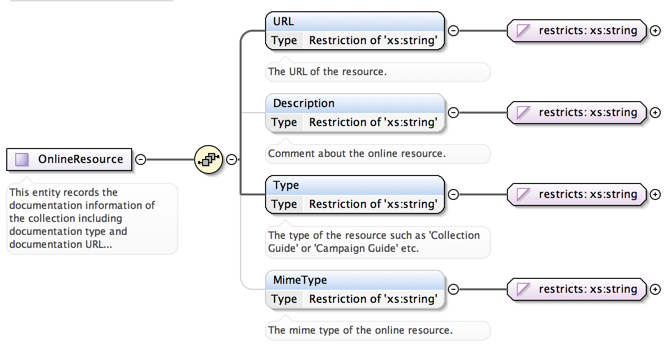The ESIP Best Practice
The ESIP OpenSearch Best Practices documents a means to expose these URLs in a meaningful way. It is detailed below:
7.2.7 Characterizing OPeNDAP Link Elements (Optional)
In addition to these basic link types, some data providers may offer a variety of data access points to the same data. An example of this is data providers that offer data via the OPeNDAP standard, which itself has several different return types: specific forms of metadata or data in varying formats. In order to distinguish OPeNDAP data access points from simple FTP or HTTP URLs, as well as from each other, an xlink-based scheme has been adapted to identify the type of OPeNDAP access point. An OPeNDAP service link is identified by a <link> attribute of the type “xlink:role”. In this case, specifically, the xlink role and type attributes are given as:
xlink:role="http://xml.opendap.org/dap/dap2.xsd" xlink:type="simple"
In addition, the combination of the rel attribute, mime-type (i.e., type) attribute and xlink:arcrole attribute are used to distinguish the different types of OPeNDAP response:
Server Response Type
rel
type
xlink:arcrole
HTML
describedby
text/html
#html
info
describedby
text/html
#info
DDX
describedby
application/xml
#ddx
RDF
describedby
application/rdf+xml
#rdf
ASCII
enclosure
text/plain
#ascii
NetCDF
enclosure
application/x-netcdf
#netcdf
Note that a search engine is not required to return all of these responses when identifying OPeNDAP links, just the ones that it (a) supports and (b) wishes to advertise to clients.
It is understood that inclusion of these xlink elements can cause a Discovery response to fail validation by some Atom feed validators, but this has been traded off for the extra information this construct provides to client programs about the options for obtaining data and metadata from the provider.
The drivers behind this, at first glance, verbose means of describing an OPeNDAP service are as follows:
- OpenSearch wishes to expose all possible formats to a client that doesn't understand OPeNDAP.
An OPeNDAP-savvy client could take a URL to a resource and, knowing that it was an OPeNDAP URL, infer that appending various extension would yield meaningful results.
A client that doesn't understand OPeNDAP would not be able to exploit a net-cdf version of this resource without being explicitly told that.
So ESIP recommends that all formats of the resource be explicitly called out. For example,
the OPeNDAP resource
| Code Block |
|---|
http://podaac-opendap.jpl.nasa.gov/opendap/allData/coastal_alt/preview/L4/OSU_COAS/weekly/osu_cioss_weekly_msla_geovel_1992_v1.nc.gz |
Would be represented in an OpenSearch result as:
| Code Block |
|---|
<entry>
...
<link href="http://podaac-opendap.jpl.nasa.gov/opendap/allData/coastal_alt/preview/L4/OSU_COAS/weekly/osu_cioss_weekly_msla_geovel_1992_v1.nc.gz.html"
hreflang="en-US" title="(OPeNDAP)" rel="describedby" type='text/html'
xmlns:xlink="http://www.w3.org/1999/xlink" xlink:role="http://xml.opendap.org/dap/dap2.xsd"
xlink:type="simple" xlink:arcrole='#html' />
<link href="http://podaac-opendap.jpl.nasa.gov/opendap/allData/coastal_alt/preview/L4/OSU_COAS/weekly/osu_cioss_weekly_msla_geovel_1992_v1.nc.gz.info"
hreflang="en-US" title="(OPeNDAP)" rel="describedby" type='text/html'
xmlns:xlink="http://www.w3.org/1999/xlink" xlink:role="http://xml.opendap.org/dap/dap2.xsd"
xlink:type="simple" xlink:arcrole='#info' />
<link href="http://podaac-opendap.jpl.nasa.gov/opendap/allData/coastal_alt/preview/L4/OSU_COAS/weekly/osu_cioss_weekly_msla_geovel_1992_v1.nc.gz.ddx"
hreflang="en-US" title="(OPeNDAP)" rel="describedby" type='application/xml'
xmlns:xlink="http://www.w3.org/1999/xlink" xlink:role="http://xml.opendap.org/dap/dap2.xsd"
xlink:type="simple" xlink:arcrole='#ddx' />
<link href="http://podaac-opendap.jpl.nasa.gov/opendap/allData/coastal_alt/preview/L4/OSU_COAS/weekly/osu_cioss_weekly_msla_geovel_1992_v1.nc.gz.rdf"
hreflang="en-US" title="(OPeNDAP)" rel="describedby" type='application/rdf+xml'
xmlns:xlink="http://www.w3.org/1999/xlink" xlink:role="http://xml.opendap.org/dap/dap2.xsd"
xlink:type="simple" xlink:arcrole='#rdf' />
<link href="http://podaac-opendap.jpl.nasa.gov/opendap/allData/coastal_alt/preview/L4/OSU_COAS/weekly/osu_cioss_weekly_msla_geovel_1992_v1.nc.gz.cdf"
hreflang="en-US" title="(OPeNDAP)" rel="enclosure" type='application/x-netcdf'
xmlns:xlink="http://www.w3.org/1999/xlink" xlink:role="http://xml.opendap.org/dap/dap2.xsd"
xlink:type="simple" xlink:arcrole='#netcdf' />
<link href="http://podaac-opendap.jpl.nasa.gov/opendap/allData/coastal_alt/preview/L4/OSU_COAS/weekly/osu_cioss_weekly_msla_geovel_1992_v1.nc.gz.ascii"
hreflang="en-US" title="(OPeNDAP)" rel="enclosure" type='text/plain'
xmlns:xlink="http://www.w3.org/1999/xlink" xlink:role="http://xml.opendap.org/dap/dap2.xsd"
xlink:type="simple" xlink:arcrole='#ascii' />
...
</entry> |
- OpenSearch wishes to convey, explicitly, the capabilities of an OPeNDAP service since not all versions of OPeNDAP support all formats
Meaning the above result represents an up-to-date OPeNDAP server. Other servers may not support net-cdf fo
OpenSearch and CMR Metadata
CMR OpenSearch decorates a CMR ATOM response, at the collection and granule levels, with OpenSearch specific elements and augmentations.
In order to expose OPeNDAP url information as per the ESIP recommendations we need to know the following,
- that a resource falls in the OPeNDAP category
- What mime type it is
- what subset, if any, of OPeNDAP formats it supports
Currently, the ECHO10 result format will identify a url of type 'OPeNDAP' as follows,
| Code Block |
|---|
curl https://cmr.earthdata.nasa.gov:443/search/concepts/G550016-GHRC <OnlineResource> <URL>http://ghrc.nsstc.nasa.gov/opendap/ssmi/f14/monthly/</URL> <Type>OPeNDAP</Type> </OnlineResource> |
That same resource in ATOM gives (note CMR is still using the 'old' relations to describe a link)
| Code Block |
|---|
curl https://cmr.earthdata.nasa.gov:443/search/concepts/G550016-GHRC.atom <link href="http://ghrc.nsstc.nasa.gov/opendap/ssmi/f14/monthly/" hreflang="en-US" title="(OPeNDAP)" rel="http://esipfed.org/ns/fedsearch/1.1/data#"></link> |
In order for CMR OpenSearch to expose this as an OPeNDAP resource we would need from CMR, at a minimum, some means of identifying it as an OPeNDAP url.
| Code Block |
|---|
If we wanted to convey what formats that OPeNDAP implementation supports we have a bigger problem. That information would need to be obtained from the provider.
CMR
Metadata URL Support
UMM-C
In the Unified Metadata Model for Collections, all URLs are mapped into the RelatedURL element. This element looks almost identical to the existing DIF Related_URL.
Here is a sample mapping from UMM-C to the DIF and ECHO 10 elements:
| UMM-C Element Specification | DIF Mapping | ECHO 10 Online Access | ECHO 10 Online Resource |
|---|---|---|---|
RelatedUrl/ContentType/Type | RelatedUrl/ContentType/Type | - | OnlineResource/Type* |
| RelatedUrl/ContentType/Subtype | RelatedUrl/ContentType/Subtype | - | OnlineResource/Type* |
| RelatedUrl/URL | RelatedUrl/URL | OnlineAccessURL/URL | OnlineResource/URL |
| RelatedUrl/Description | RelatedUrl/Description | OnlineAccessURL/Description | OnlineResource/Description |
| RelatedUrl/MimeType | RelatedUrl/MimeType | OnlineAccessURL/MimeType | OnlineResource/MimeType |
* The ECHO OnlineResource/Type element is used by some DAACs to provide Subtype via a colon delimited string (e.g. 'GET DATA : OPENDAP DATA (DODS)').
ECHO
via Online Access URL
via Online Resource
DIF 9.9
via Related_URL
Current Usage
Granule
ECHO 10 Format
| Code Block | ||||
|---|---|---|---|---|
| ||||
(https://cmr.earthdata.nasa.gov:443/search/concepts/G550016-GHRC) <OnlineResource> <URL>http://ghrc.nsstc.nasa.gov/opendap/ssmi/f14/monthly/</URL> <Type>OPeNDAP</Type> </OnlineResource> |
| Code Block | ||||
|---|---|---|---|---|
| ||||
(https://cmr.earthdata.nasa.gov:443/search/concepts/G2921045-PODAAC) <OnlineAccessURL> <URL>http://podaac-opendap.jpl.nasa.gov/opendap/allData/coastal_alt/preview/L4/OSU_COAS/weekly/osu_cioss_weekly_msla_geovel_1992_v1.nc.gz.html</URL> <URLDescription>The OPENDAP location for the granule.</URLDescription> </OnlineAccessURL> |
| Code Block | ||||
|---|---|---|---|---|
| ||||
(http://testbed.echo.nasa.gov/reverb/granules/G1000021178-EDF_OPS) <OnlineAccessURL> <URL>http://f5eil01v.edn.ecs.nasa.gov:24336/opendap//FS1/MOST/MOD29P1D.005/2011.01.01/MOD29P1D.A2011001.h13v27.005.2011002082448.hdf.html</URL> <MimeType>text/html</MimeType> </OnlineAccessURL> |
Collection
ECHO 10 Format
| Code Block | ||||
|---|---|---|---|---|
| ||||
(https://cmr.earthdata.nasa.gov:443/search/concepts/C186901238-GSFCS4PA)
<AdditionalAttributes>
<AdditionalAttribute>
<Name>OPeNDAPServer</Name>
<DataType>STRING</DataType>
<Description>Access the AIRS L2 Cloud-Cleared Infrared (IR) Radiances Product through OPeNDAP.</Description>
<Value>http://airsl2.gesdisc.eosdis.nasa.gov/opendap/Aqua_AIRS_Level2/AIRI2CCF.005/contents.html</Value>
</AdditionalAttribute>
</AdditionalAttributes> |
| Code Block | ||||
|---|---|---|---|---|
| ||||
(https://cmr.earthdata.nasa.gov:443/search/concepts/C114367117-GSFCS4PA) <OnlineResource> <URL>http://disc2.nascom.nasa.gov/opendap/TRMM_L3/TRMM_CSH/</URL> <Description>OPeNDAP Access dataset TRMM Monthly 0.5 degree x 0.5 degree Convective/Stratiform Heating</Description> <Type>GET DATA : OPENDAP DATA (DODS)</Type> </OnlineResource> |
DIF Format
| Code Block | ||||
|---|---|---|---|---|
| ||||
(http://gcmd.gsfc.nasa.gov/KeywordSearch/Metadata.do?Portal=GCMD&MetadataType=0&MetadataView=Full&KeywordPath=&EntryId=GES_DISC_TRMM_CSH_V6)
<Related_URL>
<URL_Content_Type uuid="2f1f3f44-61d5-48db-a8ac-06e3f777bf35">
<Type>GET DATA</Type>
<Subtype>OPENDAP DATA (DODS)</Subtype>
</URL_Content_Type>
<URL>http://disc2.nascom.nasa.gov/opendap/TRMM_L3/TRMM_CSH/</URL>
<Description>
OPeNDAP Access dataset TRMM Monthly 0.5 degree x 0.5 degree Convective/Stratiform Heating
</Description>
</Related_URL> |
Recommendations
Granule
ECHO 10 Format
Providers will describe their OPeNDAP urls, at a granule level, as follows
| Code Block | ||||
|---|---|---|---|---|
| ||||
<OnlineResource>
<URL>http://podaac-opendap.jpl.nasa.gov/opendap/allData/coastal_alt/preview/L4/OSU_COAS/weekly/osu_cioss_weekly_msla_geovel_1992_v1.nc.gz</URL>
<Type>GET DATA : OPENDAP DATA (DODS)</Type>
<MimeType>application/x-gzip</MimeType>
</OnlineResource> |
Advantages
Given this information a client could, understanding it was an OPeNDAP resource, invoke services on that granule by changing the extension and/or query string to the url. For example,
- GET http://podaac-opendap.jpl.nasa.gov/opendap/allData/coastal_alt/preview/L4/OSU_COAS/weekly/osu_cioss_weekly_msla_geovel_1992_v1.nc.gz.html - to get a form for processing the file
- GET http://podaac-opendap.jpl.nasa.gov/opendap/allData/coastal_alt/preview/L4/OSU_COAS/weekly/osu_cioss_weekly_msla_geovel_1992_v1.nc.gz.ascii - to get an ascii representation of the data
- GET http://podaac-opendap.jpl.nasa.gov/opendap/allData/coastal_alt/preview/L4/OSU_COAS/weekly/osu_cioss_weekly_msla_geovel_1992_v1.nc.gz.ddx - to get a description of the capabilities of the OPeNDAP resource
- netcdf?
Collection
ECHO 10 Format
Providers may describe collections of granules with the same OPeNDAP capabilities at the collection level as follows,
| Code Block | ||||
|---|---|---|---|---|
| ||||
<OnlineResource>
<URL>http://airsl2.gesdisc.eosdis.nasa.gov/opendap/Aqua_AIRS_Level2/AIRI2CCF.005/contents</URL>
<Type>GET DATA : OPENDAP DATA (DODS)</Type>
</OnlineResource> |
DIF Format
Current usage by GES DISC is good. We recommend sticking with this.
| Code Block | ||||
|---|---|---|---|---|
| ||||
(http://gcmd.gsfc.nasa.gov/KeywordSearch/Metadata.do?Portal=GCMD&MetadataType=0&MetadataView=Full&KeywordPath=&EntryId=GES_DISC_TRMM_CSH_V6)
<Related_URL>
<URL_Content_Type uuid="2f1f3f44-61d5-48db-a8ac-06e3f777bf35">
<Type>GET DATA</Type>
<Subtype>OPENDAP DATA (DODS)</Subtype>
</URL_Content_Type>
<URL>http://disc2.nascom.nasa.gov/opendap/TRMM_L3/TRMM_CSH/</URL>
<Description>
OPeNDAP Access dataset TRMM Monthly 0.5 degree x 0.5 degree Convective/Stratiform Heating
</Description>
</Related_URL> |
Advantages
Given this information a client could, understanding it was an OPeNDAP resource, invoke services on that granule by changing the extension and/or query string to the url. For example,
- GET http://airsl2.gesdisc.eosdis.nasa.gov/opendap/Aqua_AIRS_Level2/AIRI2CCF.005/contents.ddx - to get a description of the capabilities of the OPeNDAP resources that are children of this resource
Using this technique a client could infer the properties of many granule resources at a time without having to grab a ddx file for each granule.


